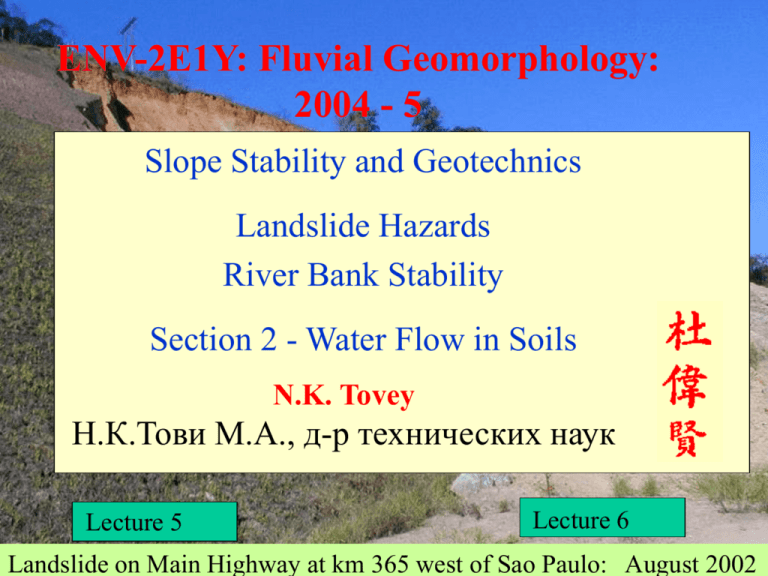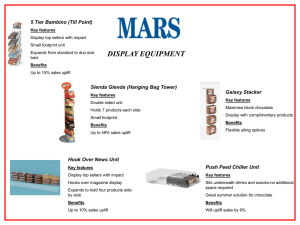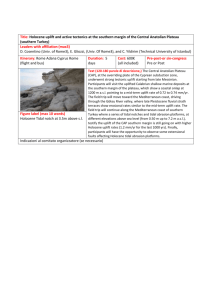Flow of Water in Soils
advertisement

ENV-2E1Y: Fluvial Geomorphology: 2004 - 5 Slope Stability and Geotechnics Landslide Hazards River Bank Stability Section 2 - Water Flow in Soils N.K. Tovey Н.К.Тови М.А., д-р технических наук Lecture 5 Lecture 6 Landslide on Main Highway at km 365 west of Sao Paulo: August 2002 2.1 Introduction • Three component parts to the water pressure:- – pressure arising from a static head (wZ) – excess pore water pressure (pressure head differential which actually causes water flow. (u ) wv – a velocity head = 2g •total pore water pressure (pwp) = H total = head Z u w position + pressure + head head 2 v2 2g velocity head w v2 w Z u 2g 2.2 Hydraulic Gradient Pressure at A is w h1 and at B is w h2 Standpipes h1 h2 hydraulic gradient = i P1 h1 h2 Water In more generally P2 Water Out B A Soil Sample i dh ds NOTE: The hydraulic gradient as defined above is dimensionless (i.e. has no units). some other disciplines i w ( h1 h2 ) .....(kNm-3) Fig. 2.1 Flow of water in a simple channel section 2.3 The Permeameter - (Constant Head) Water IN h va Q At Q - flow rate At - cross section area Darcy’s Law z va k i k dh ds k - coefficient of permeability 2.5 Results from Permeameter Loose Dense e=0.744 Quicksand occurs k=5.89 mm/s Medium Dense e=0.620 k=2.93 mm/s 2.5 Results from Permeameter m - total mass of sand A - cross section of sand column L - length (height) of column of sand Volume occupied = A.L Volume of Sand grains = e AL m m Gs w Gs w m Gs w ALG s w 1 m Further Comments about Permeability • Falling Head Permeameter is used for clays - in constant head permeameter, flow rate is far to small to get meaningful readings • Formation of a Quicksand - Piping • occurs when upward seepage force = downward force from self weight icrit hcrit A t ' Gs 1 z At w 1e 2.10 Flow of Water in Soils • Analogies in Heat Flow and Electricity – In HEAT FLOW - (ENV-2D02) kA Q (1 2 ) Where Q is the heat flow rate 1 is the internal temperature 2 is the external temperature A is the cross-section area k is the thermal conductivity is the path length – In the FLOW of ELECTRICTY kA I ( E1 E 2 ) Where I is the current E1 is the inlet voltage E2 is the outlet voltage A is the cross-section area k is the electrical conductivity is the path length 2.10 Flow of Water in Soils (continued) • In the FLOW of WATER in SOILS kA Q ( h1 h2 ) 1) Where Q is the water flow rate h1 is the inlet head h2 is the outlet head A is the cross-section area k is the permeability is the path length Mathematical solutions a) exact solutions for certain simple situations b) solutions by successive approximate - e.g. relaxation methods 2) Graphical solutions 3) Solutions using the electrical analogue 4) Solutions using models Only graphical methods will be used in this course 2.12 Graphical Solutions - Flow Nets Flow Lines 1) flow lines and equipotentials are at right angles to one another. Equipotentials 2) the cylinder walls are also flow lines. 3) distances between the equipotentials are equal Water IN head drops between the equipotentials are also equal. 2.12 Asymetric Flow 2.12 Asymetric Flow C A B • Intersections are at right angles • approximate to curvilinear square D 2.12 Asymetric Flow C a A B • Intersections are at right angles • approximate to curvilinear square D 2.12 Asymetric Flow (continued) pressure drop between AB and CD is H and let there be nd pressure drops and nf flow lines. kH By Darcy' s Law : v ki nd kHa q f kia nd and a where qf is the flow per unit cross-section and a x 1 is the cross- section between flow lines. kH qf nd the total seepage = nf qf n f kH nd h H i nd Summary of Flow Nets Solutions are relatively straightforward. 1) draw the appropriate flow net 2) count the number of pressure drops in the flow net (over the relevant distance) 3) count the number of flow lines 4) do a simple calculation – – – work out total flow work out pressure at any given point etc. 2.13 Seepage around an obstruction H B A 2.13 Seepage around an obstruction upward seepage force = downward force of the soil = A quicksand will occur if N ab w H nd ' N ab w H ' nd or N ab H ' nd w actual downward force of the soil Factor of safety = ----------------------------------------------------------downwards force required to resist seepage force ' nd Fs w H N ab In the above example, but very approximately nd = 10 and ' = w so Nab ~ 3.5 10l Fs 3.5H i.e. the distance must exceed 0.35 times the difference in head of water. 2.14 Flow nets Summary Rules for drawing flow nets:1) All impervious boundaries are flow lines. 2) All permeable boundaries are equipotentials 3) Phreatic surface - pressure is atmospheric, i.e. excess pressure is zero. Change in head between adjacent equipotentials equals the vertical distance between the points on the phreatic surface. Water 4) All equipotentials are at right angles to flow lines table h 5) All parts of the flow net must have the same geometric proportions h (e.g. square or similarly shaped rectangles). h 6) Goodh approximations can be obtained with 4 - 6 flow channels. More accurate results are possible with higher numbers of flow channels, but the h time taken goes up in proportion to the number of channels. h The extra precision is usually not worth the extra effort. 2.17 Uplift on Obstructions Uplift arises the total water pressure exerted on the base. Static head (constant for flat based obstruction) excess head. 4m 6m Head of Water (m) 3m 4 3 2 1 0 0 1 2 3 Distance under obstruction (m) 2 2.17 Uplift on Obstructions If total uplift force > the self weight downward object will be displaced downstream. Draw flow net Plot graph of uplift pressure (Y –axis) against distance along base (X-axis). Uplift pressure is estimate from flownet head at the upstream head is ~0.75 of total head head at the down stream end it is ~0.25 of the total head. 2.17 Uplift on Obstructions • Base of the obstruction is 2m below the surface • uplift force from the static head is 2w multiplied by width (i.e. 6w kN per metre length). • the upward force is the area under the curve multiplied by w. In this example upward force = 6w kN per metre length, i.e. in this case it equals the static head uplift. total uplift = 12w kN m-1. Uplift reduces ability of the obstruction to resist movement through the pressure of water potential boulder blockages in a river man-made drop structure built in river engineering works to dissipate energy (see RDH's part of the Course). quicksand might form at the down stream end of the obstruction. 2.3 The Permeameter - (Constant Head) Water IN h z







